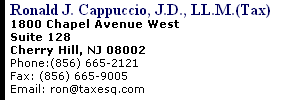Contracts are part of everyday business, whether it’s the
minuscule print on the back of a credit card bill or an
agreement to buy office furniture. With your customers,
contracts can be letter agreements, or 6-page documents,
depending on whether the deal is simple or complex.
But no matter what you’re agreeing on, one side is going to
be liable if something goes wrong. And parties to a contract
usually try to bat this liability back and forth like a tennis
ball during a killer match.
Aside from being careful in your transaction, making sure
customers are satisfied and carrying adequate insurance, you
can avoid winding up in court by legally declining to be
responsible if certain things go wrong.
There are two
protections your attorney might include when drafting
contracts:
1. Disclaimers: The Negative
Side
One
time-honored way of reducing your exposure is by using
disclaimers. Basically, they say: “I’m happy to do business
with you but I can’t guarantee that nothing will go wrong. And
if certain things do go wrong, you’re on your own.”
A disclaimer lists things
the provider is not responsible for. For example, many
companies disclaim the accuracy of links on their Web sites.
Let's say you operate a consulting firm that does
feasibility studies on commercial real estate sites. A
customer wants to put up a five-store strip mall and comes to
you to examine the location and write up an analysis
report about the site. A disclaimer sets out the
negatives.
For example: “Our company has gotten a team
together to examine and evaluate the site. We’ve done a
professional job and uncovered facts that will help you decide
whether or not to go ahead with the center. The final decision
is up to you and we can’t be responsible if these problems
arise . . .”
2. "Hold-Harmless"
Provisions: The Positive Side
Disclaimers are
similar to another legal protection known by a more cumbersome
phrase — the “hold harmless” provision. Basically, they are
two sides of the same protective coin.
But while a
disclaimer lays out the negatives, a hold-harmless clause sets
out the positives. In the above example about the strip mall,
what will a customer do for you if someone attacks your
company's report and tries to use it as the basis for a
lawsuit? You want to make it clear that the customer is
voluntarily relying on your feasibility report and you refuse
responsibility for anything except gross
negligence.
Here's an example of what a provision might
sound like: “Although we have used our best professional
efforts to deliver a complete and accurate report, you agree
to indemnify us and hold us harmless for any loss, damage or
liability (including reasonable attorney’s fees) to either
yourself or a third party, which may be based on using the
information contained in the report.”
A hold-harmless
provision transfers responsibility differently than a
disclaimer by having the user positively assume the risk. The
"indemnity" part shifts financial responsibility to the user
if the provider gets sued.
Consult
with your attorney about the wording of disclaimers and hold
harmless provisions. Here are some of the items your attorney
might include in a contract:
 What the
protection extends to (such as damage or monetary
losses). What the
protection extends to (such as damage or monetary
losses).
 Whether the
protection extends to others (beyond the customer) who rely
on the information. Whether the
protection extends to others (beyond the customer) who rely
on the information.
 Mistakes or
omissions that are specifically not guaranteed. Mistakes or
omissions that are specifically not guaranteed.
 Positive actions
for the customer to take (for example, check local laws with
an attorney to determine their impact on the report.) Positive actions
for the customer to take (for example, check local laws with
an attorney to determine their impact on the report.)
Disclaimers and
hold-harmless provisions are part of the larger picture of
risk management. While working to make your business the best
it can be, call us at (856) 665-2121 to get legal advice to
consider what could go wrong. To help keep your company out of
the courthouse, do your best to prevent problems and cover
your bases as completely as possible.

| 



















































